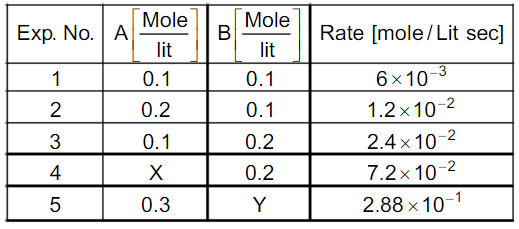For the reaction 2A+3B+32C→3P the correct relation between rate of reaction of species A,B,C is
dnAdt=23dnBdt=43d(nCdt)
2dnAdt=3dnBdt=32d(nCdt)
32dnAdt=dnBdt=34d(nCdt)
dnAdt=dnBdt=d(nCdt)
The correct Answer is:A
To find the correct relation between the rates of reaction of species A, B, and C for the reaction:
2A+3B+32C→3P
we will derive the relationship step by step.
Step 1: Write the Rate of Reaction Expression
The rate of reaction can be expressed in terms of the change in concentration of the reactants. For the given reaction, we can express the rate of reaction (R) in terms of A, B, and C as follows:
R=−12d(A)dt=−13d(B)dt=−23d(C)dt
Step 2: Relate the Rates of Change
From the rate expressions, we can relate the rates of change of concentrations of A, B, and C based on their stoichiometric coefficients:
1. For species A:
R=−12d(A)dt⟹d(A)dt=−2R
2. For species B:
R=−13d(B)dt⟹d(B)dt=−3R
3. For species C:
R=−23d(C)dt⟹d(C)dt=−32R
Step 3: Combine the Relations
Now we can express the rates of change of A, B, and C in terms of R:
d(A)dt=−2R,d(B)dt=−3R,d(C)dt=−32R
Step 4: Formulate the Final Relation
To express the relationship clearly, we can set the equations equal to each other:
−12d(A)dt=−13d(B)dt=−23d(C)dt
Multiplying through by 6 (the least common multiple of the denominators) gives:
3d(A)dt=2d(B)dt=4d(C)dt
Final Answer
Thus, the correct relation between the rates of reaction of species A, B, and C is:
d(A)dt:d(B)dt:d(C)dt=2:3:4
R=−12d(A)dt⟹d(A)dt=−2R
R=−13d(B)dt⟹d(B)dt=−3R
R=−23d(C)dt⟹d(C)dt=−32R
Similar Questions
Knowledge Check
The rate equation for the reaction 2A+B→C is found to be : rate = k[A] [B] The correct statement in relation to this reaction is that the
Aunit of k must be s−1Bt1/2 is a constantCrate of formation of C is twice the rate of disappearance of ADvalue of k is independent of the initial concentration of A and B.The rate equation for the reaction 2A+B→C is found to be : rate = k[A] [B] The correct statement in relation to this reaction is that the
Aunit of k must be s−1Bt1/2 is a constantCrate of formation of C is twice the rate of disappearance of ADvalue of k is independent of the initial concentration of A and B.The rate equation for the reaction 2A+B→C is found to be : rate = k[A] [B] The correct statement in relation to this reaction is that the
Aunit of k must be s−1Bt1/2 is a constantCrate of formation of C is twice the rate of disappearance of ADvalue of k is independent of the initial concentration of A and B.
For the reaction 2A + 3B to 4C, rate of appearance of C is equal to
View SolutionFor the reaction : A+2B→C+D, the expression of rate of reaction will be :
View SolutionFor a given reaction 3A + B → C + D the rate of reaction can be represented by:
View SolutionIn the reaction A+B→C+D, the concentration of A and B are equal and the rate of the reaction is rate =k[A][B]. The integrated rate equation for this reaction is
View Solutionfor the reaction, 2A+B→3C+D, which of the following does not express the reaction rate
View Solution

